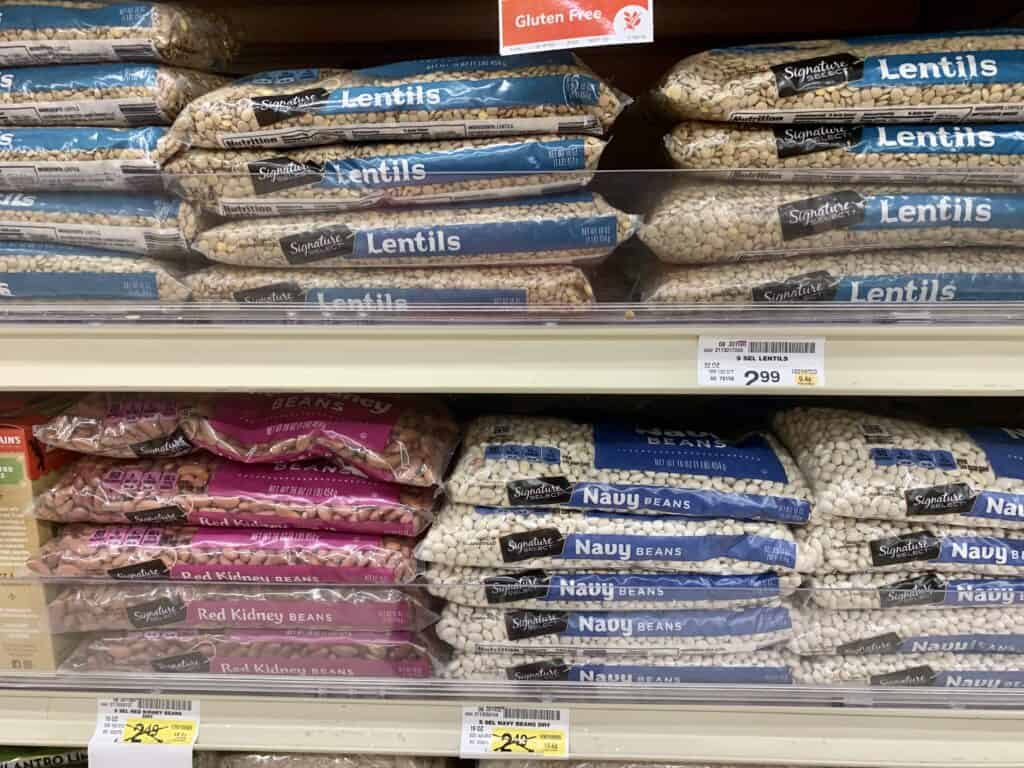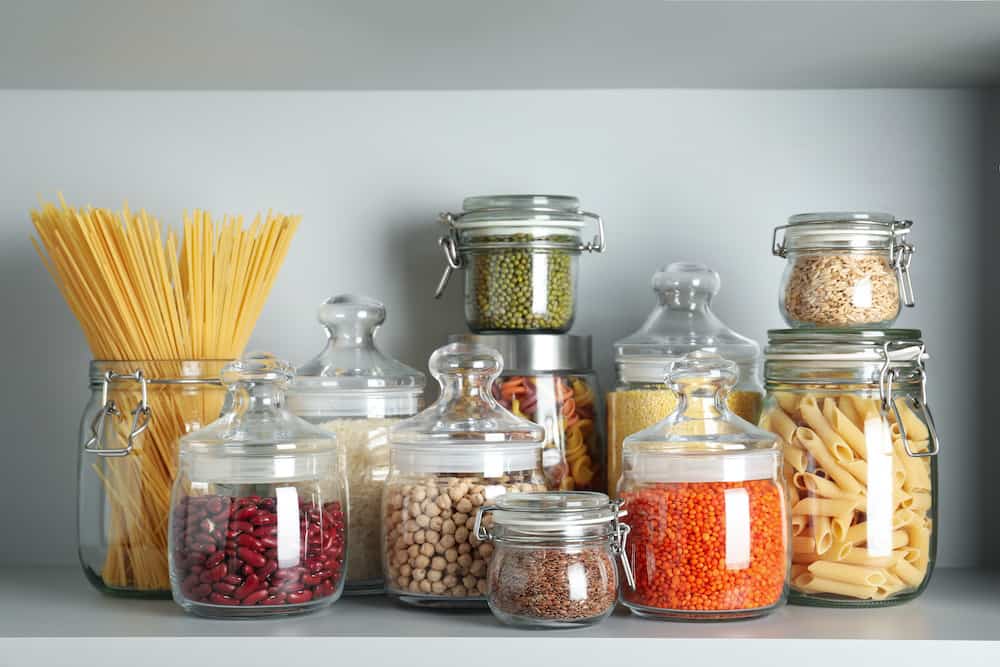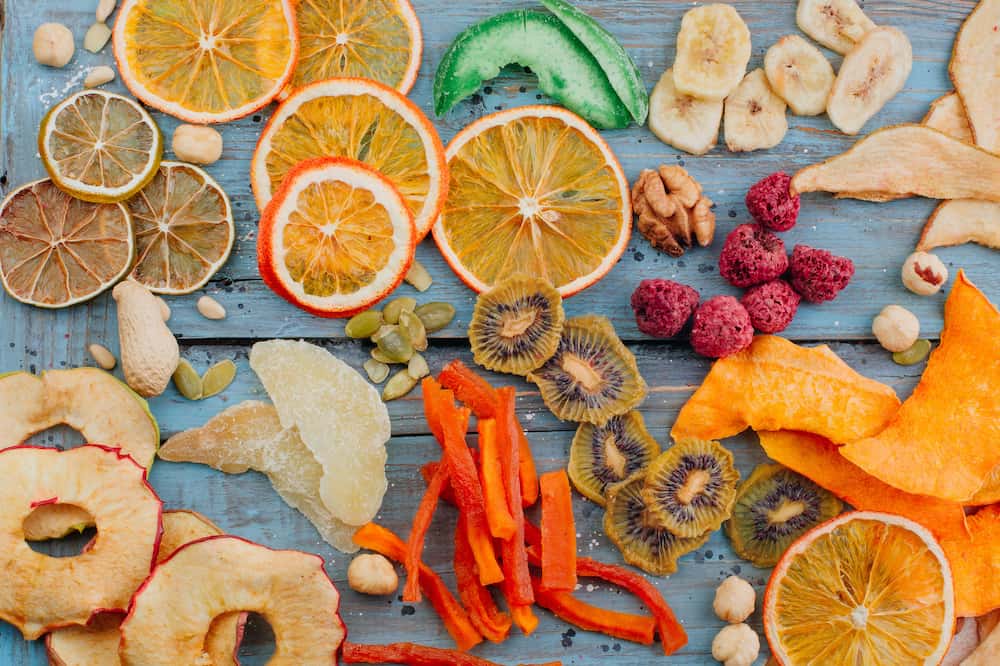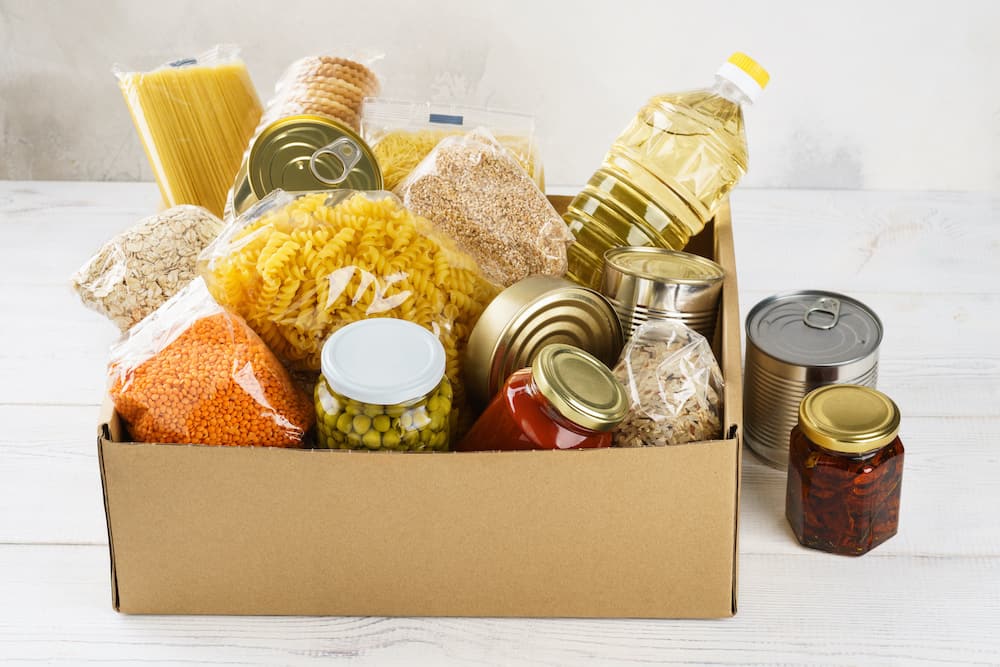Learning how to store food long term is something that has helped people for centuries, beginning with families who had pantries, larders, and root cellars. Back then, long-term food storage was a necessity, as it was the only way to keep meals fresh without refrigeration like we have today.
In modern society, preparing food for long-term storage can be a fantastic means of survival during emergencies, times of illness, and more. It is highly recommended that every family consider having enough supply put aside to last for a few months. Start with a goal of having a three month supply of foods you regularly enjoy.
If you have always been curious about having your own food pantry with enough reserves for your family, as well as a sufficient amount of extras, this guide will prove invaluable to you.
How Long Can You Store Food?
It’s important to know long you can store food properly. Food can be stored for various lengths of time, depending on what you have chosen to add to your stockpile.
Some food items, such as dry beans and white rice, are going to last substantially longer than fresh greens. This is especially true if you assume that you won’t have access to refrigeration in an emergency such as a tornado or hurricane where you may lose power.
The primary objective of getting all of the perfect foods for long-term storage is to consider their best-by dates.
In addition, you need to consider the various ways to help them last much longer than on the shelf of a grocery store. You will find foods that last up to three months, whereas others can remain edible for years. This is particularly essential for homeowners who want to amass enough long-term food storage.
If you’re opting for more medium-term storage, typically up to three months, you can focus more on satisfying and comforting meals rather than foods packed with essential vitamins and minerals.
Long-term food storage is designed to last for years. These include ingredients that have a shelf life of over 25 years, as long as they are properly packaged.
How Long Is Food Safe in the Fridge?
The convenience of having access to a fridge during an emergency would be a immeasurably helpful, especially as there’s no guarantee when your electricity will go out.
However, not every family is interested in preparing for survival. They may be simply curious as to how long their favorite foods can last when refrigerated.
To ensure you don’t make yourself ill with harmful bacteria, we used charts from foodsafety.gov to learn more about the refrigerated lifespan of most foods.
Refrigerated at 40°F or below
| Food Type | Refrigeration Period |
| Raw Pork | 3 to 5 days |
| Raw Poultry | 1 to 2 days |
| Raw Beef | 1 to 2 days |
| Soups and Stews | 3 to 4 days |
| Eggs | 3 to 5 weeks |
| Leftovers | 3 to 4 days |
| Lunch Meats | 2 weeks (unopened) |
Frozen at 0°F or below
| Food Type | Frozen Period |
| Raw Pork | 4 to 12 months |
| Raw Poultry | 1 year |
| Raw Beef | 3 to 4 months (ground), 4 to 12 months (steaks) |
| Soup and Stews | 2 to 3 months |
| Eggs | Do not freeze |
| Leftovers | 2 to 6 months |
| Lunch Meats | 1 to 2 months |
What is the Best Survival Food with Long Shelf Life?
When you begin to look into survival foods with the most extended shelf life, you’ll find that there is a wide assortment of things that you can invest in that will last a substantial period.
With that said, the most crucial aspect of keeping food safe to consume is to ensure it is appropriately stored. Otherwise, it will spoil quickly.
The best survival food with the most extended shelf life is dried beans and rice. When rice and beans are stored properly, they can last up to 30 years.

The best way to make sure your rice and beans stay fresh and food-safe will be to put them in air-tight containers that help to prevent the buildup of moisture, which is responsible for spoiling foods over time.
You can easily find an assortment of survival food manufacturers that will ship beans to you in pre-sealed air-tight containers, so you won’t have to invest in specialized equipment on your own. Also, you can guarantee that beans can make a fantastic meal when paired with the right spices.
If you don’t have the budget or ability to store larger air-tight containers, you can also buy bags of beans and lentils. Keep them in their bags and put them in gallon-sized bags, getting all the air out. Store them in a cool, dry place in a cabinet.

What Foods Should I Stockpile for Survival?
Aside from rice and beans, you must have plenty of other types of food in your long-term storage, as you will need plenty of vitamins and minerals to sustain yourself in the long run. Food security will relieve a lot of stress. Several of the other highest recommended foods to have in your pantry include:
1. Soft Grains
Items such as grits, barley, quinoa, and rye offer far more than creating a delicious breakfast. They also provide up to eight years of food-safe storage when sealed appropriately.
It is imperative that oxygen absorbers are added to the containers and that they are sealed; otherwise, they are likely to spoil. Typically, it’s best to directly purchase soft grains in an air-tight container from the manufacturer.
2. Hard Grains
Another grain to keep an eye out for are hard grains, such as white wheat, millet, and buckwheat. They can be used for an assortment of user-friendly recipes at a moment’s notice. Unlike soft grains, hard grains can last much longer (up to 12 years) with proper storage. Guide to storing grain in buckets
3. Flour
During a state of emergency or a natural disaster, one of the main items that fly off your grocery store’s shelves is flour, simply because it’s one of the most multi-purpose ingredients that is also affordable.
Fortunately, flour has a remarkable shelf life of up to 25 years, as long as it is unground. Ideally, you will want to have the appropriate equipment to ground the flour on an on-demand basis, ensuring it has its maximum shelf life. You will also want to make sure that it is stored in a sealed package with an oxygen absorber.
4. Dry Pasta
An exciting feature of dry pasta is that it has the potential to last substantially longer than you’d think, especially if you’re someone who typically goes by the best-before dates on packaging.
Most types of dry pasta at your local grocer will last up to two years beyond its expiry date, making it an excellent option for making comforting meals in a pinch. On average, pasta can last up to 30 years, which puts it in the same league as beans and rice, especially if it’s kept in an air-tight container. Consider several varieties, including whole wheat pasta.
5. Canned Beans
If you would prefer to focus primarily on canned foods for a medium-term storage solution, canned beans can be a great alternative to dried ones. You can expect most canned beans to last up to six years, as long as they are stored in a cool and dry place. One of the most important things when canning foods is to consider botulism, as it can be deadly.
6. Dehydrated Fruits and Vegetables
More homeowners are investing in dehydrators because they are relatively easy to use, and are a great way to make your own dried fruits to snack on throughout the week. Also, check your oven. Many have dehydrating features.
You’ll have a variety of options to dehydrate. They can provide much-needed calories in emergency situations. Dehydrating food is a great way to preserve food from spoiling as well.
A dehydrator can be an invaluable resource when it comes to prepping for an emergency. You can dry out apples, grapes, plums, apricots, and more to help them last up to 30 years appropriately stored.
It’s important to note that dried fruit you buy from grocery stores is likely not to be sufficient, as moisture can be reabsorbed into the fruit when it is packaged. Many of them contain added oils which can go rancid when stored long term.
As with any other type of food that you have stored, you must regularly check for signs of spoilage, which can present itself as a foul smell, oozing, or mold.
Long-term food storage companies will also have an extensive list of dehydrated fruits to choose from that arrive pre-packaged and with moisture absorbers in them.
Within the same category, you can opt to buy or make dehydrated vegetables to help ensure you and your family can get a sufficient amount of vitamins and minerals many years.

7. Dried or Freeze-Dried Meats
If you didn’t have access to refrigeration during an emergency, you likely wouldn’t survive by eating meat because it spoils relatively quickly when stored at temperatures above 40°F. A fantastic alternative is to opt for dried meats, with store-bought varieties lasting up to two years if the packaging remains unopened.
An even better solution is to make your own. Ensure that you use lean meats, though, as they are going to last much longer than fatty cuts.
Curing meats is a specialty skill, but it is an excellent skill to have at your disposal to make sure you don’t have to go without the essential proteins from some of your favorite meats. You will also be responsible for making sure you have the proper packaging to prevent oxygen from permeating the seal as well as making sure the meat is stored away from sunlight.
Freeze-dried meat is another popular alternative, as it guarantees that your meat will stay safe for up to 15 years when stored properly.
8. Canned Meat
There are many different types of canned meat that you can find at the grocery store. Canned meat can give you up to five years of food supplies as long as you ensure to check them for botulism before eating.
We buy canned chicken from Costco. It’s called Kirkland Canned Chicken which comes with eight cans. It is less expensive per can than at the grocery store. If you don’t have a Costco or Sam’s Club membership, buy canned chicken and meats from Walmart or Target.
When you start looking into canned meats for your reserves, you’ll want to choose recipes with two main ingredients: meat and salt. Otherwise, they could spoil faster and only offer up to two years of shelf life.
9. Peanut Butter
As an essential for many people’s breakfasts, peanut butter is a fantastic ingredient due to its high fat content. It’s also high in calories. It is tasty when you pair it with an assortment of meals.
You’ll be glad to know that instead of the regular jars of pre-made spread that you find at the grocery store, you can also opt for powdered peanut butter, which will last much longer and can be used on an on-demand basis.
Powdered peanut butter has up to 15 years of shelf life compared to up to two years of shelf life that you’d get with pre-mixed batches.
If you opt for buying and rotating food that you will eat, and want to buy peanut butter jars instead of peanut butter powder, you can buy it at Costco, Sam’s Club, Walmart, etc. instead of the grocery store, for more cost savings.
10. Sugars and Sweeteners
You’ll be glad to know there are plenty of sugars and natural sweeteners that can last indefinitely in your food storage, such as raw honey. You must store these ingredients with care. For example, raw honey can be spoiled if it is exposed to water, so it needs to be in a moisture-proof container.
Another great alternative is white sugar, brown sugar, powdered, or cane sugar, which can also be stored indefinitely when hermetically sealed.
Pure maple syrup is a popular choice among survivalists. Maple syrup can add a lot to recipes, such as candied bacon, sausage, oatmeal, even rice, etc., but you will need to make sure the brand you are buying is 100% pure maple syrup.
Many of the popular grocery-bought brands don’t contain real maple syrup in their ingredients. Instead, for cost savings, they contain corn syrup and high fructose corn syrup as the two main ingredients along with chemicals to preserve the “syrup.”
The same can be said about corn syrup, whether the jar has been opened or remained sealed.
11. Powdered Milk
Another tremendous essential that is likely to be sold out in any store during an emergency is powdered milk. This is because powdered milk can last up to 25 years if you store it in a cool and dry location.
One of the most considerable benefits of this option is that it’s easy to tell when it has gone sour, as it will turn to a yellow color and smell rancid.
12. Seasonings and Spices
Any type of seasoning that you have should be dry, if possible. On average, most seasonings and spices can last up to four years, depending on how you store them. You can opt for larger containers or smaller ones, depending on how much you enjoy them. Consider spices for “spicing up” rice dishes, quinoa, etc. and cinnamon and nutmeg for oats, millet, barley, etc.
13. MREs
Although they can be more costly than other types of survival food, MREs seem to be one of the most popular choices for people who need quick on-the-go meals that are easy to put together.
There are a ton of different recipes that you can find, ranging from chicken teriyaki to macaroni and cheese. They are incredibly convenient because they come with an on-board cooking solution.
By following the few steps on the back of the packaging, you can prepare hot meals paired with dessert in a matter of minutes. The only issue with MREs is that their shelf life will vary drastically depending on where you buy them from.
Some manufacturers have MREs that can last up to 30 years, whereas others may only last up to 10 years. As such, it is essential to read the product description before buying. Some have noted that they are not the most enjoyable meals in the world.
However, they are packed with vitamins and minerals to give you prolonged vitality in an emergency, including natural disasters. They are ideal emergency food rations.
14. Cans of Vegetables
Canned vegetables are options if you use them by the “use by” date. This can be 1 – 5 years, depending on what it is and where you buy it from. Acidic foods won’t last as long as non-acidic. This is something to stock up on when they are on sale, rotate and then replenish.
What Should I Use to Store Survival Food?
Considering that purchasing food from emergency food suppliers can be very expensive, it will likely be more cost-effective to package your emergency supplies at home. For this, you’d have to make sure that you have the proper packaging tools. Airtight containers are essential. You can use them for all kinds of foods.
Not only will you need to check that you have items that can be hermetically sealed, but that you also have a collection of oxygen absorbers to help prevent your food from spoiling.
One of the most cost-effective solutions for storing large and small quantities of dried foods is the use of mylar bags, especially as you can buy them in bulk for relatively low prices.
Mylar bags for food storage are typically made out of food-safe foil. They help to block oxygen and light from penetrating your food which will cause it to spoil early.
However, they are not the best option for people who need to protect their food from rodents, as plastic bags are incredibly easy to chew through. A more heavy-duty option could be food-safe plastic buckets. Food-grade buckets can help foods last up to 30 years when stored in ideal conditions.
Apart from the type of packaging you choose, you will also want to make sure your pantry is convenient and safe for optimal food protection. It should be a cool and dry location that does not rely on HVAC to be temperature-controlled, which is why cold cellars or underground pantries are a favorite among preppers.
An extra freezer is nice, but if you don’t have electricity, everything will eventually spoil.
It’s also essential to make sure there aren’t any sources of light that could affect your packaging. If possible, opt for a room that doesn’t have windows. Consider building a root cellar.
How Much Food Should I Store Long Term?
When deciding how much food to have for an emergency, the things you will want to consider first are the:
- Number of people you intend on feeding
- Length of time you want to prepare for
- How much space you have to store it
These three factors can significantly impact the amount of food you’ll need to purchase and store to make sure you have enough for your loved ones.
You will also want to consider whether you’ll be a good Samaritan and give some of your food reserves to your neighbors, or if you intend to isolate yourself away from others.
When it comes to food, at the very least, every home should have up to seven days’ worth for each family to eat three meals per day, with snacks, but that is the very minimum. You will want to consider the length of time you want to prepare for and adjust your ratios as necessary.
Clean Water
While enough calories per day are important, dehydration will be a more immediate concern than starvation in an emergency. Having a supply of clean water should be your top priority. This is especially important if you have highly active people in your household that will have a list of responsibilities to attend to.
You will also want to take your environment into account. Hot climates will require individuals to have more water than cold temperatures. This is true for dry climates as well.
It’s also essential to have enough clean water to keep up with food preparation and hygiene. You won’t want family members falling ill due to improper hygiene.
At a minimum, you should have a two-week supply of water for each family member, as suggested by FEMA, with one gallon of water per person per day.
How to Store Food Long Term
When you’re figuring out how to store food long term and planning your emergency food supply, there are plenty of steps to take to ensure you’re making the most out of your time and money. Safety is key.
Before buying anything, check the expiration dates. Keep foods that are expiring sooner in the front so you can use them and not waste them.
When buying bulk foods, many people think of canned vegetables, white rice, and dry beans but there are additional easy-to-store foods such as a variety of freeze-dried foods and dehydrated foods. Remember also just-add-water meals.
With proper storage, you can have several types of food that last up to 30 years. While not an indefinite shelf life, when well thought out, it is an excellent food storage plan.
This will guarantee your family is sufficiently covered in an emergency. Having a variety of food also means you can rotate and replenish it.
Related articles:


Awesome! Thank you for this amazing information!!